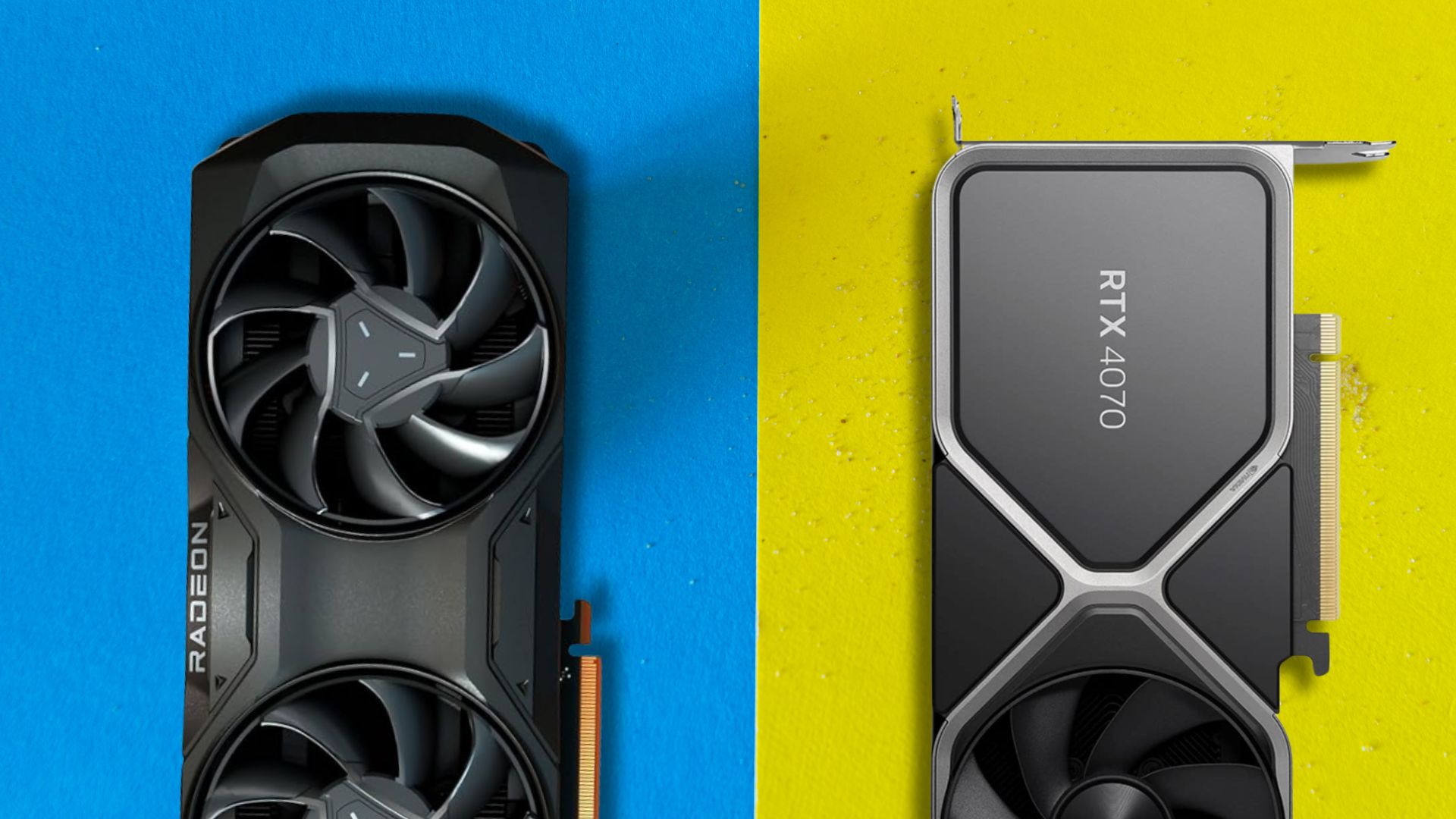Let’s compare the RX 7800 XT and RTX 4070, two direct competitors. This follows our previous comparison of the RX 7900 XTX and RTX 4080, where RTX 4080 had slightly better performance.
If you’re searching for the ultimate gaming experience and wondering which card reigns supreme, you’re in the right place. Stay tuned as we delve into the nitty-gritty of performance and efficiency to help you decide which card is the better buy for your gaming needs.
RTX 4070 vs RX 7800 XT: Differences
| RX 7800 XT | RTX 4070 | |
|---|---|---|
| Architecture | RDNA 3 | Ada Lovelace |
| Process | 5nm, 6nm | 4nm |
| Transistors | 28.1 billion | 35.8 billion |
| Shader Units | 60 | 5,888 |
| Ray Accelerators/Cores | 60 | 46 |
| Stream Processors | 3,840 | 46 |
| Base Clock Speed | 2,124MHz | 1,920MHz |
| Boost Clock Speed | 2,430MHz | 2,480MHz |
| Memory Bus | 256-bit | 192-bit |
| Memory Bandwidth | 2,708.4GB/s | 504.2GB/s |
| Power Draw | 263W | 200W |
RTX 4070 vs RX 7800 XT: Game Benchmarks
When making an informed decision about performance, game benchmarks are crucial. Tech YES City used the following equipment to test the RTX 4070 and RX 7800 XT.
Testing Rig
- CPU: i9-13900K
- Memory: 7600MHz DDR5
- Motherboard: ASRock Z790 Lighting
- Power Supply: 1000W ASUS Thor
- AMD GPU: ASRock Phantom Gaming RX 7800 XT
- Nvidia GPU: Galax EX-Gamer RTX 4070
1. Robocop: Rogue City


In this recently released title, both the RTX 4070 and the RX 7800 XT deliver neck-and-neck performance at both 1080P and 1440P high settings.
2. Fortnite


Similar to RoboCop Rogue City, both GPUs showcase similar performance in Fortnite at both resolutions.
3. Apex Legends


Here, the RX 7800 XT takes the lead in terms of FPS at both 1080P and 1440P. However, it’s worth noting that the NVIDIA card performs better in terms of the 1% lows, which is crucial for competitive gaming.
4. Starfield


As an AMD-sponsored title, it’s no surprise that the RX 7800 XT outperforms the RTX 4070 in Starfield. This game was tested at low settings, where the performance difference between the two GPUs is significant.
5. Returnal


In Returnal, the AMD cards again take the lead in FPS at 1080p and 1440p. However, the 1% lows favor the RTX 4070, giving it an advantage in that metric.
6. Baldur’s Gate 3


In this graphics-intensive game, both GPUs face a challenging scene. While the RTX 4070 struggles, the RX 7800 XT performs better overall at both resolutions.
RTX 4070 vs RX 7800 XT: TDP, Undervolting & Ray Tracing
Let’s dive into the power consumption differences between the RTX 4070 and the RX 7800 XT GPUs. This is an important factor to consider when deciding which card to purchase.
The RTX 4070 requires a single 8-pin connector, while the RX 7800 XT requires a 28-pin connector. This means that the RTX 4070 is likely to have lower power consumption compared to the RX 7800 XT.

During benchmarking, it was found that the RTX 4070 had a watt usage from the wall of around 370 watts. On the other hand, the RX 7800 XT used nearly 500 watts. These measurements were taken during gameplay in Fortnite, where the FPS numbers were similar for both cards.

Undervolting is a method that can be used on both graphics cards to increase power efficiency. When undervolting, both cards show similar efficiency numbers. However, it was observed that the performance drop for RX 7800 XT was worse compared to RTX 4070.

To evaluate ray tracing performance, I ran Returnal with maximum ray tracing settings at 1080p resolution, and the results were quite revealing. When comparing average FPS in raw rasterization versus ray tracing, the RTX 4070 demonstrated a more significant advantage over the 7800 XT. Additionally, Nvidia offers DLSS 2 and 3, but AMD also provides FSR 2 and 3 for those who prefer upscaling.
RTX 4070 vs RX 7800 XT: Noise & Temperature

Both ASRock and Galax have created excellent cooling solutions for their graphics cards. The Galax GPU performs exceptionally well, maintaining a quiet operation even in a 25° ambient environment without needing any adjustments to the fan speed.

Similarly, ASRock’s Phantom Gaming OC, designed for AMD, is also remarkably quiet and effective at keeping the system cool. Both brands have done an impressive job in ensuring their GPUs stay cool and operate quietly.
Which One You Should Buy?
After completing all the necessary benchmarks and examining various cards, it’s time to provide a recommendation, but it’s important to understand that this advice is not one-size-fits-all. Different users have different requirements for their GPUs.
To reach a well-informed conclusion, I’ll share my perspective and the factors I consider crucial when selecting a GPU. However, it’s essential to tailor these considerations to your specific situation. Here are the key factors to consider:
- VRAM Requirements: For those concerned about future gaming titles and heavy VRAM needs, the AMD card, with its 16 GB of VRAM, is the superior choice. However, for those like me who are less concerned about VRAM and willing to adjust game settings as needed, this may be less of a deciding factor.
- Pricing and Location: The cost of these GPUs can vary based on your location. In the US, both the AMD RX 7800 XT and Nvidia RTX 4070 are similarly priced. This equal pricing plays a significant role in the decision-making process.
- Resale Value: Nvidia cards generally have a higher resale value, making them a more attractive option for those who plan to sell their GPU or gaming PC in the future. This factor is particularly relevant for those who frequently upgrade or change their gaming setup.
In conclusion, both the Nvidia and AMD cards offer excellent performance for gaming and streaming, including features like AV1 encoding. The choice ultimately depends on individual preferences and needs, such as VRAM requirements, budget considerations, and future resale plans.
I lean towards the Nvidia RTX 4070 for its power efficiency, advanced features like DLSS 2 and 3, and better resale value. However, both options are solid choices and unlikely to be regrettable purchases for gaming enthusiasts.






